#malted barley flour
Explore tagged Tumblr posts
Text
Roman Holidays headcannon
So Laurie Holiday's at the local market, and discovers something interesting as could prove interesting when baking bread: Nothing less than a blend of 00 flour and malted barley flour. And also picks up a few recipes worth trying with the malted flour blend.
(For the uninitiated, 00 flour is the Italian term as refers to medium-texture wheat flour; 000 is finer textured, and 0 is coarse. And given that The Roman Holidays was basically patterned on The Flintstones, but set in Imperial Rome, it might be amusing to extend such appellations for flour so applied, even if the flour was more likely to be had in bulk and was unbleached.)
#hanna barbera#headcannons#fanfic ideas#the roman holidays#00 flour#malted barley flour#hannabarberaforever
0 notes
Text

Buy Organic Malted Barley Flour - Organic Zing
Organic Zing provides the best Malted Barley Flour at very affordable prices, which is made from organic barley and wheat. Barley flour has a strong, chewy flavor and often makes up the bulk of a dough recipe. Organic Barley flour may help you maintain weight, reduce belly fat, and decrease bad cholesterol levels. Barley flour is a high protein, low gluten alternative to wheat flour and an essential ingredient in bread, rolls, and pastries. Barley is high in both soluble and insoluble dietary fiber and boasts a naturally sweet taste. Buy now at: https://organiczing.co/products/organic-barley-flour
0 notes
Text
How Confectionery is Embracing Health-Conscious Consumers
Often the confectionery is rightfully associated with the wrongful use of sugar, preservatives and artificial colourings. The health-conscious consumers of today, therefore, are limiting their consumption of chocolates, cakes, candies and cookies. To be relevant in the market thus the confectionery industry is widely embracing healthy alternatives and modes of manufacturing their products. Starting from replacing sugar to switching towards plant-based vegan-friendly ingredients, this industry is going through a rapid fundamental change that needs to be appreciated.

Opting for Sugar Substitutes
The basic fundamental change that this industry is widely accepting right now is using sugar substitutes. Sugar adversely affects the body through increasing weight, metabolic disorders, chances of diabetes, and kidney problems. That is why the confectionery industry is right now tying up with barley malt extract manufacturers as malt extracts offer the same sort of sweetness but without the harmful health implications caused by traditional sugar. Malt extract is a natural, low-calorie alternative that not only provides sweetness but a unique nutty flavour and texture to the end product you are making with it.
Vegan and Plant-based Alternatives
The world is gradually switching towards cruelty-free options even in food preferences. Vegan diets are becoming more acceptable and people are now looking after this change in their desserts and beverages too. Plant-based gummies or dairy-free chocolates are just a few examples of confectionary innovations going into the trend among health-conscious consumers of today. Partnering with a malted milk foods third-party manufacturer can help you replace dairy products with plant-based ingredients like barley malts, millet malt, or wheat malt.
Gluten-free Confectionery
One of the major setbacks in the business of the confectionary industry was the increasing rate of gluten sensitivity and celiac diseases among people. Eliminating gluten completely used to cause baked cakes or cookies, and gummies to lose their singular elasticity and softness. But malt extracts can offer the same texture and tenderness to the end products hence switching towards malt extracts is proving to be beneficial for the confectionery.
Reducing Artificial Preservatives
The confectionery industry is hugely reliant on preservatives. But the artificial preservatives, colours and flavours are not good for health. Thus, the confectionery brands are using natural fruit puree, and natural preservatives like citric acid and Vitamin E instead of artificial ones.
Conclusion
The confectionery industry is going through a massive transformation considering the health and preferences of its new-age consumers. Opting for sugar substitutes, natural plant-based colouring and preservatives, and gluten-free malt extracts are some of the prominent changes they are embracing. Thus, those who want to satisfy their sweet craving can do it without a stain on their healthy diet.
for more information about: Barle Malt Extract Please visit at https://www.mahalaxmimaltextract.com/
#liquid malt extract#barley malt powder#malt extract powder#malt extract#malted barley powder manufacturers#malt extract liquid#barley malt flour#barley malt extract#malt extract powder manufacturer#barley malt extract manufacturers
0 notes
Text
the previous allergy post made me realize that yesterday and today ive had allergic reactions and just wrote them off, so i started checking the things i had eaten and guess we have to find a different kind of flour to buy now
#i need to see an actual allergist to confirm this but at this point malt and malted barley flour have been the consistent ingredients in#everything that has made me react so like im pretty confident its that#fuck food allergies tho god i hate this#ecdysing
1 note
·
View note
Text
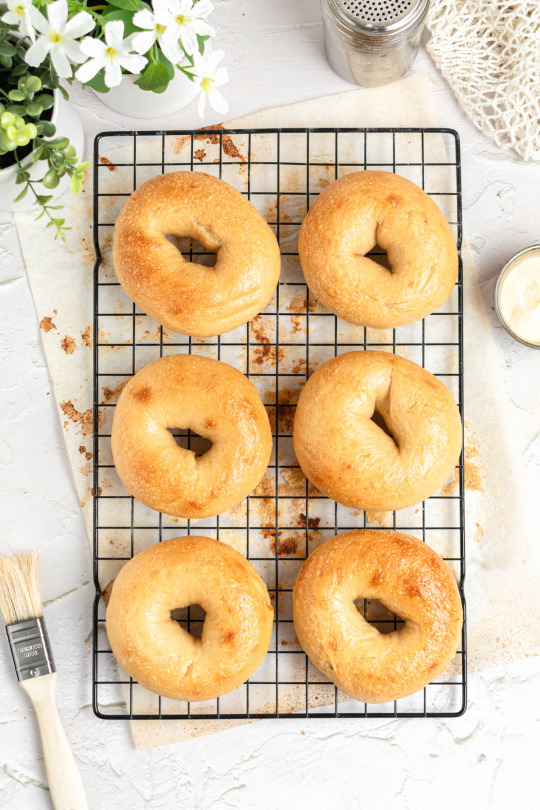

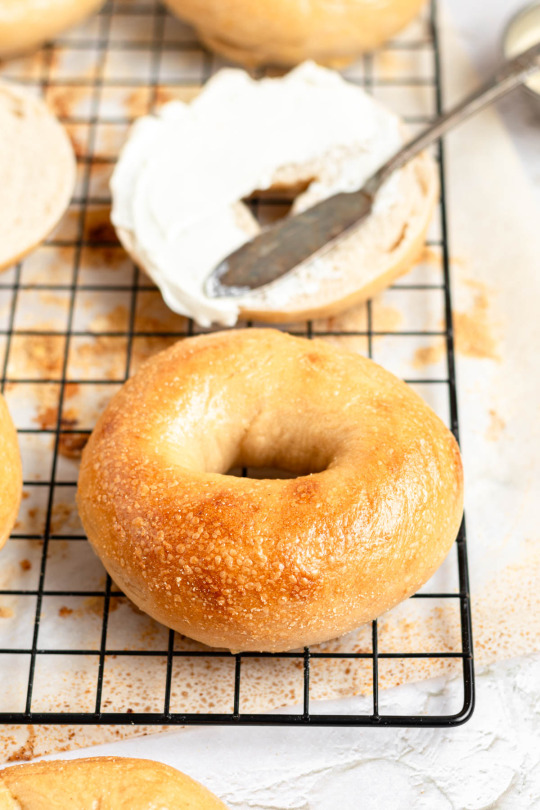
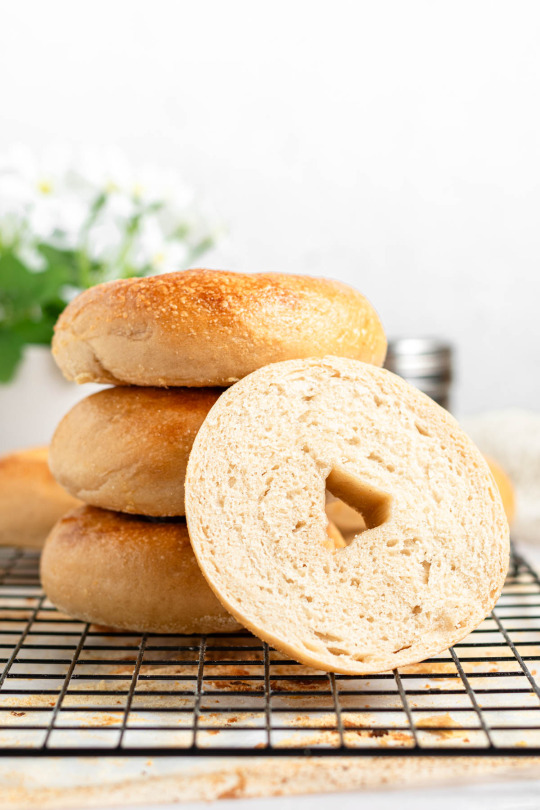
Homemade Overnight New York-Style Bagels
This might be one of my favorite recipes I’ve ever developed. So excited for you all to try it!
2K notes
·
View notes
Text
Karelian words - Traditional foods prt. 2
Kagrakiiseli - pudding made from mixture of rye bread starter and oat milk. Can be eaten sweet or savory, often with nob of butter on top.
Kapustakoašša - a soup made from pearl barley and cabbage or sauerkraut.
Kapustavoassa - soup or stew made from cabbage and beer.
Kuopsu - mixture of cream and partially mashed berries frozen up.
Lohkoi - boiled white turnip mixed with rye or malt flour and broth, thickened in oven into kind of stew.
Marjaimelä, moarjamämmi - a dish made by malting rye flour and berries and baked in oven in low heat.
Potakkarieška - thick flatbread made from mashed potatoes, milk or water mixed with flour. Occasionally bread starter is also added in.
Pyynrokka - soup made from mashed vegetables such as white turnip, potato, carrot or similar and hazel grouse, thickened up with rye flour. Typically eaten with soured cream or smetana.
Raučču - soup made from water or milk and fish roe.
Retniekka, reätniekka - side dish of salted, pickled radishes mixed with smetana or soured cream.
Riissukiiseli - pudding made by boiling leftover rice pie filling with extra milk or water. Sweetened with sugar and nuts.
Rosmoikiiseli - pudding made from milk or water mixed with rye bread starter thickened with simmering. Slightly tart in flavor.
#карельский язык#karelian#karelia#каре́льский язы́к#karelian language#karjalan kieli#karjal#karjala#kariela#karelian kieli
18 notes
·
View notes
Note
Today is my first time trying bagel with cream cheese, sorry, tasted bagel with cream cheese. I am no crying in the corner in my room BECAUSE IT TASTE SO GOOD AND FULFILLING. But goodness Bagel is so expensive in my country. I am considering making my own bagel.
Have you done try baking your own bagel before?
Hi!
Yes- bread making is my passion and people who were here in 2022 remember the bread and butter recipes I used to share. I do make my own bagels.
The first thing to note is there are different schools thoughts when it comes to bagel making. Only one matters, though, and thats New York style. It's a little more labor intensive but the end result is well worth it. I'm going to give you the actual recipe I use and one that doesn't require barley malt syrup because that can be difficult to find.
I also make mine the night before so they can sit in the fridge overnight before boiling and baking. I do think this is optimal as the flavor has a chance to really settle in as the dough rises, but it's not a requirement to the recipe.
The other thing about making any type of bread is I genuinely recommend investing in a scale to weigh your flour. Again- not a requirement, but it'll help make sure the ratios are right.
You'll need:
4 1/3 c (5412 g) bread OR all purpose flour (you'll want something with a high protein count- 3 to 4g per serving but the higher the better imo)
1tsp dry yeast (if they're going to sit overnight) or 1 tblspn for same day
1 tablespoon of sugar
2 tsp of barley malt syrup OR honey/maple syrup (or brown sugar. I recommend using syrup/honey before brown sugar but all three will lack some of the flavor of a traditional bagel that the barley malt gives it. the barley malt also gives a bagel some of its chew/shine so if you use a substitute and your bagel doesn't look like a store bought bagel, thats probably why. It's still gonna be good)
2 tsp of salt
1 1/3 c warm water (315 g)
1 tblspn vegetable oil
Even when yeast doesn't need to be proofed, I still do it anyway. You'll combine your warm water, your sugar and your yeast to a bowl and mix it together. Walk away- return in 10 minutes where your yeast should be nice and foamy.
While you wait, combine the rest of your dry ingredients into a different bowl/stand mixer
Once your yeast is foamy, pour it over your dry ingredients and any remaining wet ingredients (just oil). Mix using either a spoon or a kneading attachment until its incorporated- do not over mix it
Lightly flour a clean surface. Take your dough out and knead it for like, a minute or two. You can test if your dough has been kneaded enough by pinching off a little section and spreading it out in your hands. It should be transparent in your hands without being overly sticky or ripping. Thats the perfect kneaded texture. Be careful not to over knead
Let your dough rest for 30 mins and then divide it into 8 equal pieces. KEEP IT COVERED!!! Use cling film or a tea towel while you let it rest. Do not leave it uncovered, you will dry it out
There is a technique to rolling out circles of bread. Everyone does it a little different, I personally think my way is best. Take one of your balls and shape it with your fingers, pinching the bottom. Then roll it gently with your palm either on the counter or between your hands until you've got a nice little ball of dough
let your balls rest, COVERED, for another 30 minutes
Using your thumb, press into the center of your bagel to create a hole, and then your fingers to shape it into your desired bagel like shape
At this point, you have two options. You can either spray down a baking sheet (honestly do this either way) with a little oil and begin the next steps, or put them on your baking sheet, COVER THEM, and slide them in the fridge for the night. Some recipes will tell you to dust your baking sheet with cornmeal. You can do this- I don't, it's just an extra annoying step I don't care about. I'm not a professional baker, you know?
If you're proofing for same day baking, just let them rest another 30 mins.
Preheat your oven (either 30 mins later or a day later) to 450
Bring a pot of water to a boil. You'll want a pot big enough to do 3-4 bagels at a time and with enough water they're not touching the bottom. I googled it and a recipe said about 3 quarts. I just measure with my heart
Add your malt/sugar into the pot- I don't measure this, but you're looking for the water to be an amber color. You'll also add about idk half a teaspoon of salt?
Once your water is boiling, you're going to add 3-4 bagels at a time. DO NOT CROWD YOUR POT, it lowers the temperature of the water. You'll boil your bagels 30 seconds, flip, and then for another 30 seconds. Over boiling can destroy the fluff of your bagel and all the time we spent letting them rise. I just set a timer on my phone.
Set your boiled bagels on your baking sheet once they're sufficiently boiled
If you want to add any toppings to your bagel, now is the time. I always have everything bagel seasoning on hand (you can get this everywhere but I'm a basic bitch so I get mine from Trader Joes).
Bake 20-25 minutes
EAT
#separatist apologist bakes#this probably seems daunting but it really isn't#and honestly once you learn the basics of bread making you can make ANYTHING#bread is one of the easiest things for beginners to make#hope this was helpful!!
9 notes
·
View notes
Text
Deutschribing Germany
Cuisine
Meal times
The German proverb Iss dein Frühstück wie ein Kaiser, Mittagessen wie ein König und Abendessen wie ein Bettler (Eat your breakfast like an emperor, lunch like a king, and dine like a pauper) sums up the German outlook toward meals.
A typical day begins with Frühstück (breakfast), when people drink coffee, tea, or hot cocoa and eat muesli with yogurt or milk or bread with butter, jam, honey, chocolate and hazelnut spread, sausage, or cheese. Some people also drink juice and eat a boiled egg. This usually takes place between 6 and 8 a.m. Children usually eat a mid-morning snack at school called Pausenbrot (recess sandwich) that consists of a sandwich, a piece of fruit, or a muesli bar. The adult version is called Zwischenmahlzeit (in-between meal).
Mittagessen (lunch) takes place between 12 and 2 p.m. A typical lunch dish includes potato salad with sausage or meatballs and meat with potatoes or vegetables. It is common for family members and friends to gather between 3 and 5 p.m. for Kaffee und Kuchen (coffee and cake).
Abendessen (dinner) is eaten between 6 and 7 p.m. Sometimes it is a light cold meal with bread and cold cuts, in which case it is called Abendbrot (evening bread). Dinner normally consists of a salad or soup, bread, cheese, meat or sausages, mustard, and pickles.
Dishes
German cuisine varies from region to region, and what is considered typically German is actually typical in the south, mainly Bavaria, where cuisine is similar to that in Austria. There are also international varieties such as doner kebab, pizza, sushi, Chinese food, Greek food, Indian food, and Vietnamese food.
Bread and sausage are staples of the German diet. There are about 600 types of bread and almost 1,500 sausage varieties, including Bratwurst (made of ground pork, beef, or veal and spices) and Weißwurst (white sausage eaten with sweet mustard, a pretzel, and beer).
The national alcoholic drink is beer, of which there are many varieties, including Helles (a pale lager beer produced in southern Germany), Radler (a beer mixed with lemonade), and Weizenbier (a top-fermented beer brewed with a large proportion of wheat relative to the amount of malted barley).
Berliner/Krapfen/Pfannkuchen
These sweet dough dumplings, filled with jam and glazed with powdered sugar, are known as Berliner in northern and western Germany, Pfannkuchen in eastern Germany, and Krapfen in southern Germany.

Birnen, Bohnen und Speck
Birnen, Bohnen und Speck (pears, beans, and bacon) is a dish made with pears, green beans, and bacon, accompanied by potatoes. It is eaten in Bremen and Lower Saxony.

Bratkartoffeln
Bratkartoffeln (fried potatoes) are fried potato slices with diced bacon and/or onions.
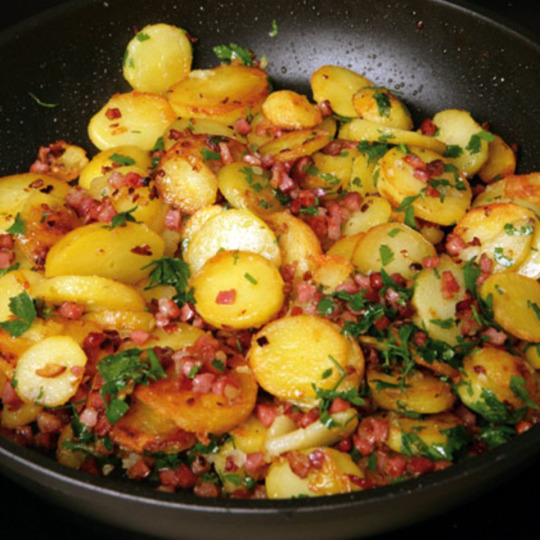
Brezel
Brezeln (pretzels) are baked pastries made from dough and shaped into a symmetrical knot. They are typically seasoned with salt, but can also have toppings such as cheese or seeds.
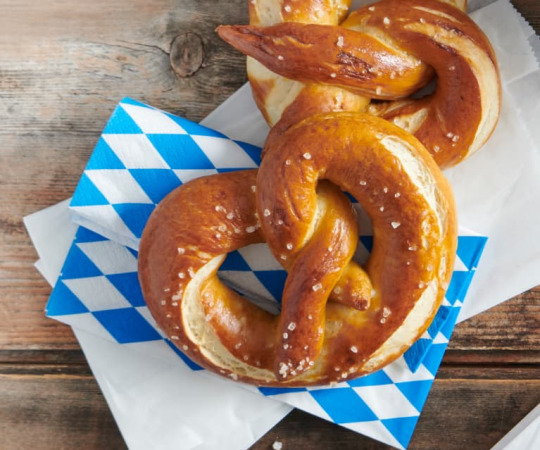
Brot
Brot (bread) comes in many different types, from white wheat bread (Weißbrot) to gray (Graubrot) to black (Schwarzbrot), which is actually dark brown rye bread. Some breads contain both wheat and rye flour and are called Mischbrot. Others have seeds such as linseed and sunflower seeds and are wholegrain (Vollkornbrot). Bread can also be made from spelt (Dinkelbrot), rye (Roggenbrot), or a mix of these with wheat.

Brötchen (bread rolls) are also very common and can be made from the same cereals and seeds as normal bread.
Currywurst
Currywurst is Berlin's most famous dish and consists of a pork sausage with ketchup and curry powder.
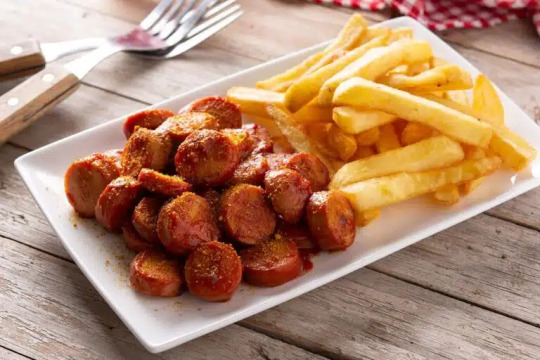
Eierschecke
Eierschecke, whose name is derived from a tripartite piece of clothing, consists of three layers: the bottom one is either a yeast dough or made with baking soda, the middle layer is a cream made of quark, vanilla, butter, egg, sugar, and milk, and the top one is made from eggs, butter, sugar, and vanilla pudding powder. It is a specialty from Saxony and Thuringia.
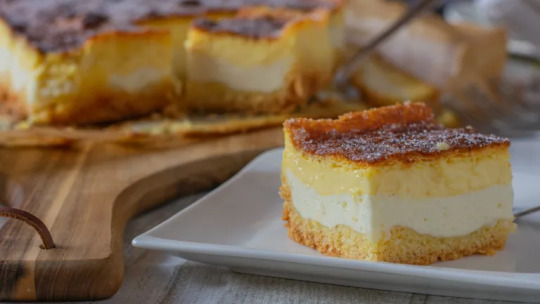
Fischbrötchen
A Fischbrötchen (fish bread roll) is a sandwich made with various fish, either pickled or fried, and onions, common in northern Germany.

Flammkuchen
Flammkuchen means "pie baked in the flames" and originates from Baden in Baden-Württemberg and the Palatinate in Rhineland-Palatinate. It is similar to a pizza with thin crust covered with crème fraîche, onions, and lardons.

Frikadellen
Frikadellen are flat-bottomed, pan-fried meatballs of minced meat. They are commonly eaten with pasta salad or potatoes, or in a bread roll with mustard.

Himmel und Erde
Himmel und Erde (heaven and earth) is a dish with mashed potatoes, stewed apples and fried blood pudding. Potatoes are also called Erdäpfel (ground apples), so it is a meal made with apples that grow above and under the earth. It is popular in the Rhineland in Rhineland-Palatinate and North Rhine-Westphalia, Westphalia in North Rhine-Westphalia, and Lower Saxony.
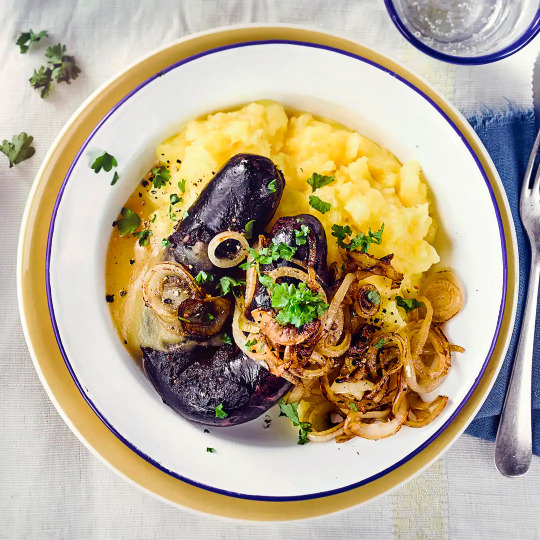
Kirschenmichel
Kirschenmichel is a kind of bread pudding made with cherries and served hot with vanilla sauce. It is typically eaten in Franconia in Bavaria and Thuringia, the Palatinate, Baden-Württemberg, and Hesse.

Klöße/Knödel
These dumplings are known as Klöße in northern, central, and western Germany and Knödel in southern Germany. They are usually made from flour, bread, or potatoes. There are different varieties, including dumplings made of ground liver or breadcrumbs.
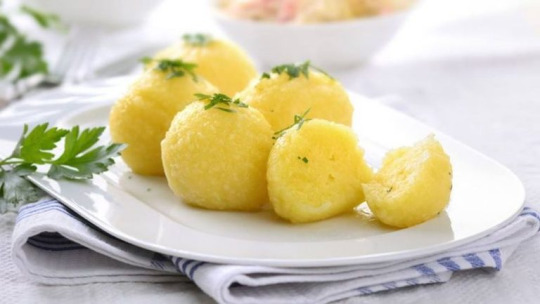
Kohlroulade
A Kohlroulade (cabbage roll) consists of cooked cabbage leaves wrapped around a meat filling seasoned with garlic, onion, and spices. Rinderrouladen are similar but consist of bacon and onions wrapped in beef.

Labskaus
Labskaus is a dish made from corned beef, herring, mashed potatoes, and beetroot, served with a fried egg and a pickled cucumber. It is typically eaten in northern Germany.
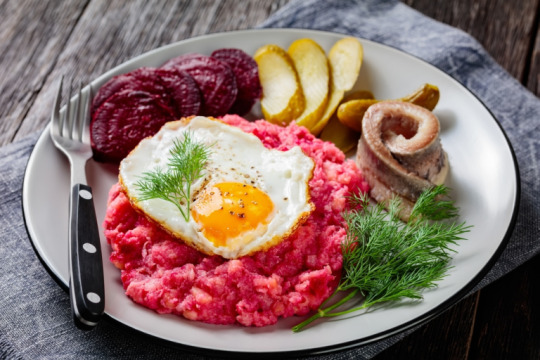
Leberkäse
Leberkäse ("liver-cheese") is eaten in Franconia, Saarland, and Swabia in Bavaria and Baden-Württemberg. It consists of beef, pork, and bacon that are finely ground and then baked as a loaf in a bread pan. It is served with an egg and mashed potatoes.

Leipziger Allerlei
Leipziger Allerlei was invented in Leipzig and consists of a mixture of peas, carrots, green beans, asparagus, morels, and celery. It may also contain broccoli, cauliflower, or corn. It is served with potatoes and a sauce made from crayfish butter, crayfish tails, and semolina dumplings.
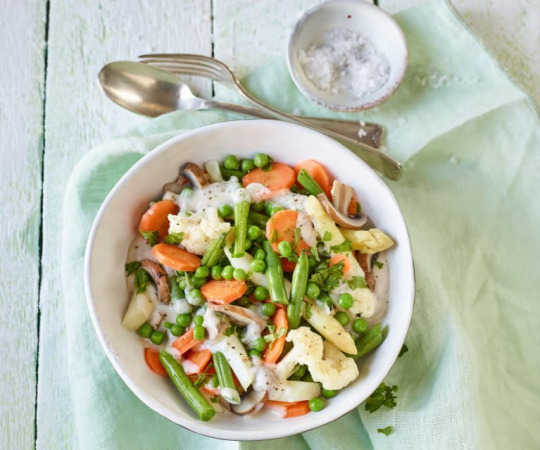
Marmorkuchen
Marmorkuchen (marble cake) has a streaked appearance, achieved by lightly blending light and dark batter. It can be a mixture of vanilla and chocolate.

Maultaschen
Maultaschen ("mouth bags") are large meat-filled dumplings typical of Swabian cuisine. They can also be filled with spinach, onions, and spices and can be either served with broth or cut into slices and fried with eggs.

Pfefferpotthast
Pfefferpotthast (boiled meat pepper pot) is a traditional Westphalian stew made with beef, lard, onions, and spices. It is served with boiled potatoes and salad in the summer and pickled cucumbers and beetroot in the winter.
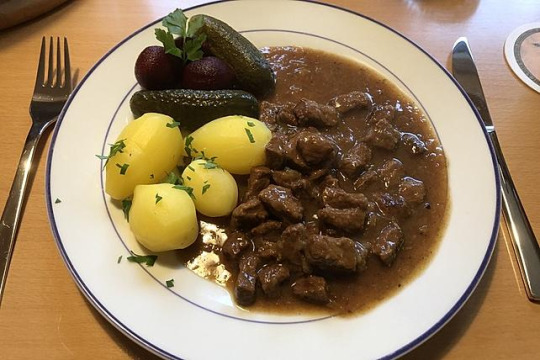
Pinkel mit Grünkohl
It is a dish made from slowly cooked kale served with Pinkel, a salty sausage eaten mainly in Bremen and Lower Saxony.
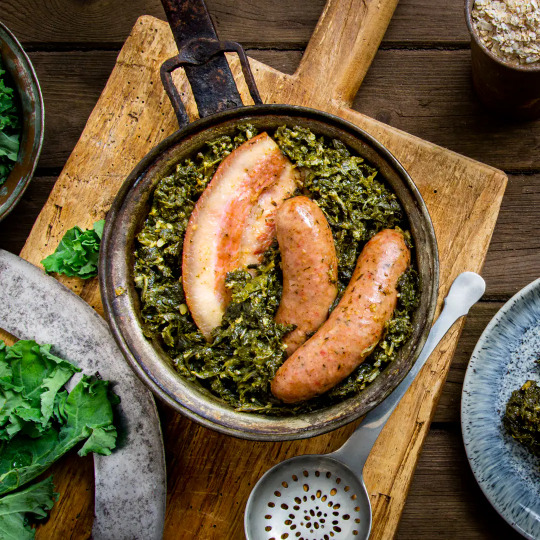
Quarkkäulchen
A Quarkkäulchen ("little quark ball") is a Saxon dish made from quark, mashed boiled potatoes, flour, an egg, and lemon peel. The dough is then baked in the form of a pancake and eaten hot with sugar and cinnamon or with fruit, whipped cream, and vanilla ice cream.

Reibekuchen
These potato pancakes are served with black bread, sugar beet syrup, or stewed apples. They are common in many areas of the country, but the name is characteristic to the Rhineland.

Rollmops
Rollmops ("rolled pug/fat young boy") are pickled herring fillets, rolled around a savory filling, usually consisting of onion and a pickle. It is a specialty from Berlin.

Sauerbraten
Sauerbraten is regarded as the national dish of Germany. It originally comes from the Rhineland and consists of large pieces of beef or horse meat, marinated in a spicy water-vinegar mixture before baking and served with Klöße.
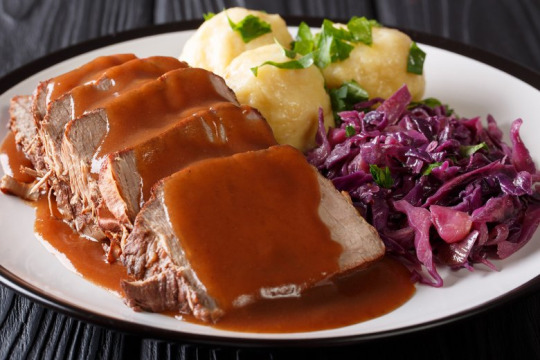
Sauerkraut
Sauerkraut is finely cut raw cabbage fermented by lactic acid bacteria.

Saumagen
Saumagen ("sow's stomach") is popular in the Palatinate and consists of a pork's stomach filled with pork, sausage meat, and potatoes. It is usually served with mashed potatoes or Bratkartoffeln and Sauerkraut.
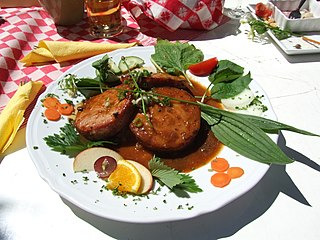
Schnitzel
A Schnitzel is a fried, breaded thin piece of meat, typically pork or beef. Although the most famous one is Wiener Schnitzel (Viennese style), there are other kinds, including Jägerschnitzel, with mushroom sauce; Rahmschnitzel, with cream sauce, and Zigeunerschnitzel, with a sauce made with tomato, bell peppers, and onion.

Schupfnudel
Schupfnudel are thick noodles typical of southern Germany. They are usually made from flour or potatoes and eggs and served with Sauerkraut.
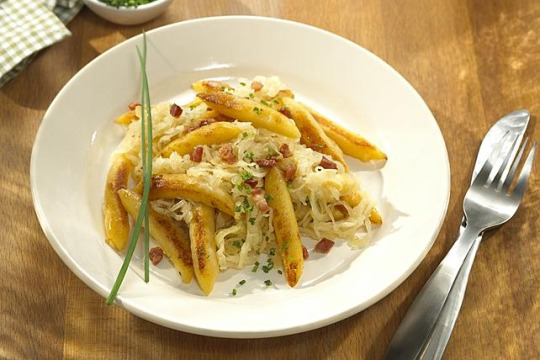
Schwarzsauer
Schwarzsauer ("black sour") is a North German blood soup with spices cooked in vinegar.

Schwarzwälder Kirschtorte
Black forest cake is a chocolate and whipped cream cake with a cherry filling and cherries on top.
Schweinshaxe
Schweinshaxe is a typical Bavarian dish of roasted ham hock served with Sauerkraut. A variation of this dish is known elsewhere as Eisbein ("ice leg"), in which the ham hock is pickled and slightly boiled.
Schwenkbraten
Schwenkbraten is a pork neck steak marinated in spices and onions. It is originally from the Saarland and grilled on a Schwenker, a grill that hangs on a chain over a wood fire.
Spaghettieis
Spaghettieis (spaghetti ice cream) is an ice cream dish made to resemble spaghetti. Vanilla ice cream is extruded through a modified Spätzle press to give it the appearance of spaghetti. It is placed over whipped cream and topped with strawberry sauce to simulate tomato sauce and either coconut flakes, grated almonds, or white chocolate shavings to represent Parmesan cheese.
Spätzle
Spätzle (little sparrow) are hand-made egg noodles, originally from Swabia. They are the main ingredient of several dishes, such as Käsespätzle (Spätzle with cheese) and Linsen mit Spätzle (lentils with Spätzle).
Streuselkuchen
Streuselkuchen ("crumb cake") is made of yeast dough covered with a sweet crumb topping (Streusel). The recipe originated in German Silesia.
45 notes
·
View notes
Text
The Irish Porridge Project
We know that cereal grains were in use in pre-Norman Ireland. We also know that yeast baking doesn't work very well in Ireland's climate, such that soda bread is the traditional Irish loaf, rather than the yeast breads and sourdoughs that most other European cuisines have. But bread soda wasn't available in period, so the bread of the medieval era seems mostly to have been flatbreads and some kind of biscuits or crackers, with yeast bread only really available to the rich and in (some) monasteries. Everyone else seems to have gotten along with porridges as the main use for grain. There's even mention of wheat porridges being the appropriate food for royal fosterlings.
"Porridge" in modern English mostly means that it's made from oatmeal, and indeed, it's called just "oatmeal" in some places. But it's possible to make porridge from any grain. The Southern US dish called grits is a maize porridge, for one example. So what I want to do over the next while is try out every kind of porridge that pre-Norman Irish people could have gotten hold of.
There is the issue that we don't actually know what all the grains were. We have a list from the 8th century Bretha Déin Chécht: bread-wheat, rye, spelt-wheat, two-row barley, emmer wheat, six-row barley, and oats, but we don't really know what some of those are, and the translations are dubious in some cases. In this case, I'm going to go for emmer, einkorn, durum, barley, rye and oats. That list may be adjusted if I find more or that some (durum, perhaps) were not available in period. I'll also look at grain-like stuffs like pendulous sedge and fat hen, and see what can be done with those.
Next, there are multiple forms of grain that can make porridge. The full grain "berry", the slightly trimmed groat, various crushed and rolled forms, and coarse and fine flours. In addition, there are malted, roasted, and fermented options for each, and different grains might be mixed. This is adding up to a lot of different porridges!
As I try them, I'll add links here and describe what results I get, including other people's opinions of them, when I get those. I have a couple of co-conspirators on this project, and as they send me the results of their trials, I'll add them here too.
I'd also like to credit Magister Galefridus Peregrinus, whose class in non-baking use of Fertile Crescent grains at Pennsic 50 jumped my initial research and thinking on this particular project by years.
Standard (Rolled) Oatmeal Porridge Steel-cut Oat Porridge Fermented Oatmeal Porridge
#irish food#medieval cooking#medieval food#sca#irish medieval food#the porridge project#medieval grains
17 notes
·
View notes
Text
Gluten free vocab & stuff
Some words to look for/avoid if you're trying to be gluten-free in France. Please feel free to correct me if anything is wrong!
Sans gluten - gluten free
La farine - flour
Le maïs - corn
Le sarrasin - buckwheat
Le blé noir - buckwheat (I saw this one more often than sarrasin)
Le blé - wheat
Pané - breaded
Croûte - crust
Le siegle - rye
L'orge - barley
L'extrait de malt d'orge - barley malt extract
L'avoine - oat
La bière - beer
épeautre -spelt
Sauce de soja - soy sauce
Contamination croisée - cross contamination
Blé dur - durum wheat
Farine de froment - wheat flour? Honestly not sure what exactly this is I just know it's gluten.
4 notes
·
View notes
Text
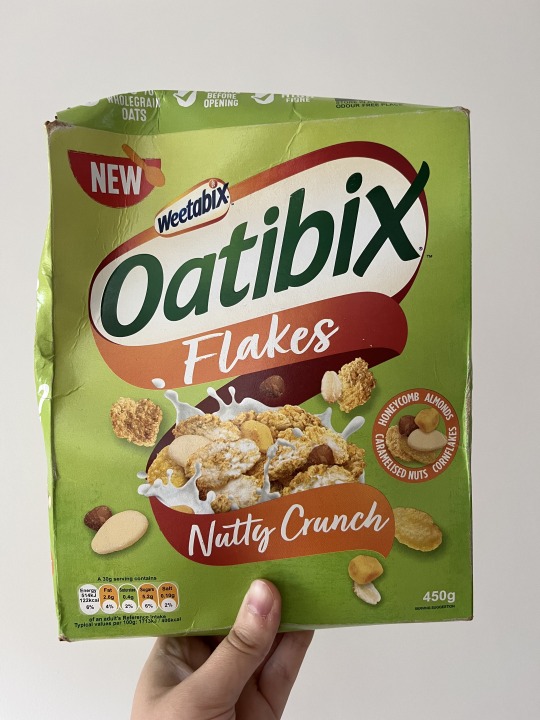
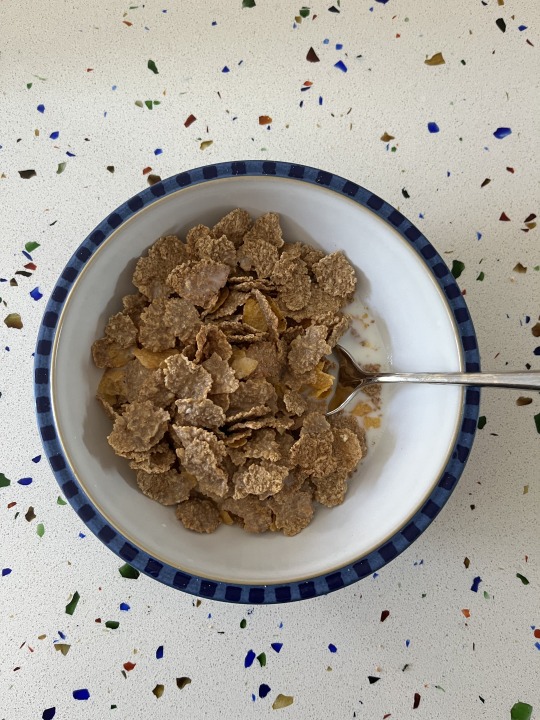
Today's cereal is Oatibix Flakes Nutty Crunch!
Initial impressions: I simply must apologize for the sorry state of this poor cereal box, purchased from a supermarket a large distance from my house, I swaddled it in my arms as I soldiered on through a thunder storm but it was clearly not enough to save it's constitution. However the inside remains just as pristine as ever for this exciting new review! Oatabix Flakes Nutty Crunch is a cereal made up of a number of different components; classic oatibix flakes, honey comb, almonds, cornflakes and caramelized nuts. Before pouring it out, I followed the instructions on the top of the box and shook vigorously. Hopefully this means a nice even distribution of bits throughout.
Post bowl thoughts: All the individual components merge here to form an extremely dusty and beige bowl of cereal, without a particularly distinct smell. When I take my first spoonful, the texture of the oatibix flakes makes me feel like my teeth are small millstones grinding against each other to turn wheat into flour. It's not all together unpleasant, but I can't shake the thought from my head as I make my way through the bowl. The additions here of honey comb, almonds, cornflakes and caramelized nuts get slightly lost and instead pop up every once and a while to add a crunch of texture. They don't impact the taste at all though, which is a shame as it means the whole bowl stays relatively bland. This is a cereal that would hugely benefit from the addition of some fruit to add a brightness to the neutral palate it possesses straight out the box. On the whole my main complaint with Oatibix Flakes Nutty Crunch is that it is not gluten free. Surely replacing the wheat in Weetabix with oats is a great way to exclude gluten from the cereal as a whole, but no. This cereal contains malt barley extract, right down near the bottom of the ingredients list. It's frustrating that clearly no thought was put into making this cereal an accessible option for people stuck with expensive and uninteresting free-from foods, when a small adjustment could have enabled it. All in all, unnecessary inclusion of gluten aside, this isn't a bad bowl of cereal. It's also not a good one. Perhaps as I work my way through the box and add some mix-ins, I'll feel more generous towards it, but as things stand I can only offer a shrug.
12 notes
·
View notes
Text
I’ve lost track of how many ambulance rides I’ve taken.
I’ve probably given over 100 epipens by now.
My thighs are permanently bruised.
I’ve stabbed my thighs with trembling hands as my eyes are going dark, hoping the air will come back and this won’t be the final time.
I found out I get steroid psychosis, so they can no longer be part of treatment, but not until after they made me gain so much weight and I lost several days of memories.
I’m scared of every food and every scent because previous safe ones have flipped to danger.
I miss peanut butter.
Malted barley flour is in so many things.
I’m terrified that I’ll develop an allergy to Ruby.
The summer heat has closed my throat too many times.
Pictures from 5 years ago I was so genuinely happy.
This has taken over my life.
I hate this.
12 notes
·
View notes
Text
What to Consider While Choosing Your Right Malt Extract Contract Manufacturing Partner?
Do you deal with the baking or beverage industry? Are you seeking a healthy alternative to regular sugar in your regular manufacturing? Malt extract can be your perfect solution. But to be profitable from your bulk purchase of malt extract, you need to choose the right Malt Extract contract manufacturing partner before anything. The experience and expertise of your malt extract manufacturer have a significant impact on the end product you deliver. Know what factors to check on before signing your next malt extract contract.

Experience and Expertise
The first and foremost factor that you will look into regarding your malt extract delivery partner is their years of experience and expertise in that field. Significant years of experience in Malted Milk Food Manufacturing assures you that the manufacturer knows the nuances of its production, formulations, and preservations. You can also ask directly the manufacturer for their expertise in dealing with your niche may it be confectionery, beverage, baking, or health drink. This will ensure their capability in meeting your industry-specific demands.
Flexibility and Scalability
The next thing that you will check on your Malted Milk Foods third-party manufacturer is whether they can meet your growing demands or not. It is very natural that with growing years your business and production demand will grow. Your malt extract partner needs to have that much flexibility to support your increasing production demand with timely supply without neglecting product quality.
Certifications
Talking about the quality of the malt extract, you must always rely on the Government authorised certifications and not merely the words of the manufacturer. You will have to verify the ISO 22000 certificates, Quality Management System certificates and Halal Product certificates to ensure the authenticity and high-quality production of the malt extract you are purchasing.
Reliability
Meeting the deadline is the most crucial thing as without it your business will be severely affected. You need to check whether your malt Malt Extract contract manufacturing partner can timely deliver your orders or not. For this, track their previous records in meeting deadlines. This will help you rely on your delivery partner and attract more challenging market demands in your specific field.
Conclusion
Choosing the right Malt Extract contract manufacturing partner, therefore, involves a few vital factors. While the flexibility and reliability of your malt extract partner is important don’t miss to check their certifications and years of expertise. Considering these factors will secure your chances of making a profitable decision and future expansion in your business itself.
for more information about: malt extract liquid Please visit at https://www.mahalaxmimaltextract.com/
#liquid malt extract#malt extract powder#barley malt powder#malted barley powder manufacturers#barley malt extract#barley malt extract manufacturers#barley malt flour#malt extract liquid#malt extract#malt extract powder manufacturer
0 notes
Text

Unbleached wheat flour, Water, Salt, Yeast, Malted barley flour, Ascorbic acid, Rice flour (for dusting).
14 notes
·
View notes
Text
Bublik looks a lot like a bagel, sounds a little like a bagel, but is not quite a bagel. Bublik (pronounced boob-leek) or bubliki (plural), is the Ukrainian version of a yeasted, boiled and rounded bread that dates back to 18th century Odessa. Just like New York or Montreal-style bagels, bubliki came to Ukraine by way of Ashkenazi Jewish immigrants from Poland and Eastern Europe, later becoming popular throughout the former Soviet Union. While bread shaped into rings dates back to the 13th century, written records of the beygl (Yiddish for bagel), date back to 1610 in Krakow, Poland, where bagels were mentioned in Jewish community ordinances. The word bublik comes from the proto-Slavic word boubl, which means swelling or bubble. These delicious rings of bread are also affectionately called bublichki, and there is even a famous Yiddish-Ukrainain song from the 1920’s with this diminutive name.
Popular across the former Soviet Union, bubliki are traditionally served with tea and topped with butter, jam or smetana(sour cream). Compared to bagels, bubliki have a tender crust, are a little sweeter and sometimes have a larger hole in their center. The chewiness of the bublik varies by baker, but they’re most often lighter than their New York counterparts. While bagels are made with a simple dough of yeasted flour and water, bubliki are typically made with an enriched yeasted dough that includes butter, egg and milk. While bagels and bubliki are both boiled in water before being baked (giving them their unmistakable glossy crust), bagels are traditionally boiled in water with barley malt syrup added to it, whereas bubliki are boiled in plain water. In some ways, the flavor of bubliki is closer to a Montreal-style bagel, which is sweetened and boiled with honey.
In all its forms, bubliki and bagels have made their way into kitchens and bakeries around the world. While it takes time to make bubliki from scratch, you will be rewarded with the incomparable joy of eating a fresh, warm bublik, and your home will be filled with the smell of one of the most comforting Jewish breads.
6 notes
·
View notes
Note
a bagel
hi here's a bagel recipe <3
Dough
1 tablespoon (9g) instant yeast
4 cups (480g) King Arthur Unbleached Bread Flour
2 teaspoons (12g) table salt
1 tablespoon (9g) non-diastatic malt powder or 1 tablespoon (14g) dark brown sugar, or barley malt syrup
1 1/3 cups (303g) water, lukewarm
Water bath
2 quarts (1814g) water
2 tablespoons (18g) non-diastatic malt powder or 2 tablespoons (28g) dark brown sugar, or barley malt syrup
1 tablespoon (14g) granulated sugar
Weigh your flour; or measure it by gently spooning it into a cup, then sweeping off any excess. Combine all of the dough ingredients and knead vigorously for 10 minutes (if you're using an electric mixer) or up to 15 minutes (if you're kneading by hand). Since we're using a high-protein bread flour here, it takes a bit more effort and time to develop the gluten. The dough will be quite stiff; if you're using a mixer it will "thwap" the sides of the bowl, and hold its shape (without spreading at all) when you stop the mixer.
Place the dough in a lightly greased bowl, cover, and set it aside to rise until it's noticeably puffy though not necessarily doubled in bulk, 1 to 1 1/2 hours.
Lightly grease two baking sheets, or line them with parchment and grease the parchment. Transfer the dough to a work surface, and divide it into eight pieces (for large bagels), or 12 pieces (for standard-size bagels).
Working with one piece at a time, roll it into a smooth, round ball. Place the balls on one of the prepared baking sheets. Cover the balls with plastic wrap, and let them rest for 30 minutes. They'll puff up very slightly.
-
While the dough is resting, prepare the water bath by heating the water, non-diastatic malt powder (or brown sugar or barley malt syrup), and sugar to a very gentle boil in a large, wide-diameter pan. Preheat your oven to 425°F.
Use your index finger to poke a hole through the center of each ball, then twirl the dough on your finger to stretch the hole until it's about 1 1/2" to 2" in diameter. Place six bagels on each of the baking sheets.
Transfer the bagels, four at a time if possible, to the simmering water. Increase the heat under the pan to bring the water back up to a gently simmering boil, if necessary. Cook the bagels for 2 minutes, flip them over, and cook 1 minute more. Using a skimmer or strainer, remove the bagels from the water and place them back on the baking sheet. Repeat with the remaining bagels.
Bake the bagels for 20 to 25 minutes, or until they're as deep brown as you like, turning them over about 15 minutes into the baking time (this will help them remain tall and round). Remove the bagels from the oven, and cool completely on a rack.
2 notes
·
View notes